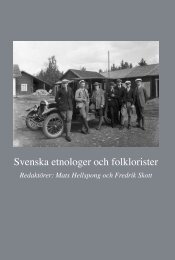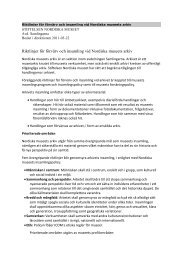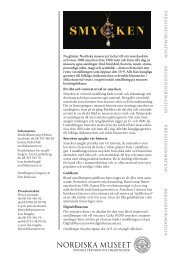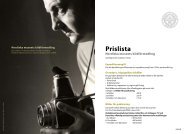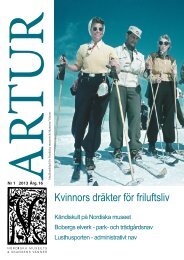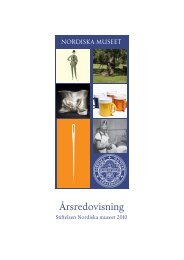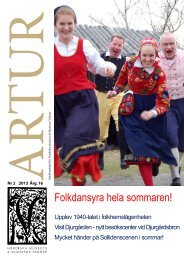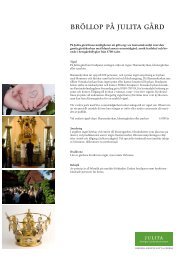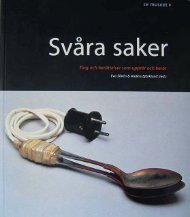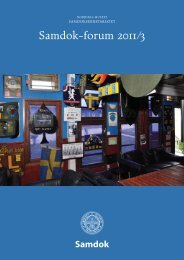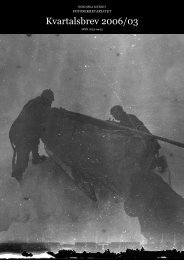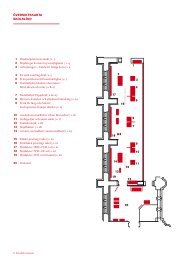Samdok - Nordiska museet
Samdok - Nordiska museet
Samdok - Nordiska museet
Create successful ePaper yourself
Turn your PDF publications into a flip-book with our unique Google optimized e-Paper software.
connecting collecting: jensen & walle<br />
change. We find it important to document and get a better<br />
understanding of how migration affects both sending<br />
and receiving countries as well as their respective<br />
populations. We are therefore currently planning to do<br />
fieldwork among Pakistanis living in Norway and follow<br />
up their relatives in Pakistan. This follow-up project will<br />
be run in cooperation between Norsk Folkemuseum and<br />
Lok Virsa in Islamabad, Pakistan.<br />
There are strong connections between the Pakistanis<br />
living in Norway and their families in their country of<br />
origin, but we also register that bonds are changing.<br />
Thus we want to study the symbolic and emotional impact<br />
of transnational links in both Pakistan and Norway.<br />
Important aspects of this research will be:<br />
• Continuity and change in gender patterns<br />
• Relations between generations, which may be transnationally<br />
dispersed or reside within the same locality<br />
We wish to conduct the project as joint fieldwork in both<br />
Norway and Pakistan, following kin networks across the<br />
borders. The team will consist of researchers and trainees<br />
both from Norway and Pakistan, including both women<br />
and men.<br />
Life story interviews and documentation of people’s<br />
homes and domestic interiors through observations,<br />
descriptions and collection of key objects will be our<br />
chosen methods. Not only do we hope to obtain valuable<br />
information and further increase our knowledge<br />
within this field, we also hope to gain experience from<br />
the collaboration with Lok Virsa in working on a bilateral<br />
project.<br />
We will continue to train interviewers, in the manner<br />
that was developed during the above-mentioned project<br />
period. We will train personnel of immigrant background,<br />
both first- and second-generation immigrants, by offering<br />
training courses in interview techniques. To improve<br />
these interviews, we plan to spread the seminars over<br />
several days. The introduction course will be followed up<br />
by courses where we comment on the interviews held,<br />
before they conduct follow-up interviews. Our aim is to<br />
build competence within designated groups, and subsequently<br />
engage them in future projects. Considering the<br />
changing interests of museums and in culture politics, it<br />
is important to have competent personnel available for<br />
different projects. On a longer time scale, this will also<br />
improve the possibilities to recruit people with minority<br />
backgrounds for regular positions in museums.<br />
During the initial project described above, we saw<br />
that it was difficult to collect objects to be included in the<br />
museum’s collection. There were various reasons for this,<br />
but partly because the initial project emphasised immaterial<br />
culture when obtaining information as a basis for<br />
future analysis. A second impediment was deciding what<br />
kind of objects to select and collect, and whether suitable<br />
objects were available. During the upcoming project we<br />
will take measures to enable the collection of objects, by<br />
focusing on key objects that are ascribed symbolic importance<br />
by the people being interviewed.<br />
This will be a continuing focus on similar future<br />
projects, and on systematic documentation of the material<br />
realities of people’s lives through photography and<br />
film, an approach used by both Norsk Folkemuseum and<br />
IKM. There are also plans for both indoor and outdoor<br />
exhibitions.<br />
While the project Norsk i går, i dag, i morgen? originated<br />
from the governmental call to include new groups<br />
of people in the undertakings of culture institutions and<br />
acknowledge the emergence of a multicultural society<br />
(NOU 1996:7), demographic developments during the<br />
last decade have resulted in a stronger emphasis on cultural<br />
diversity as a whole. Based on this, we chose to redefine<br />
Norsk Folkemuseum as a multicultural museum.<br />
Rather than merely focusing on immigrant and ethnic<br />
minorities as particular segments of society in opposition<br />
to a ‘general’ Norwegian population, which tends to<br />
emphasise discrete divisions between relatively homogeneous<br />
groups, we should now consider contemporary<br />
society as a meeting place between individuals. These<br />
individuals may differ along a number of variables, such<br />
as gender, ethnicity, class, age etc, but will also share experiences<br />
and values. Cultural diversity at the museum<br />
thus needs to have an intersectional perspective on contemporary<br />
society.<br />
A further challenge will be to include cultural diversity<br />
in all aspects of the museum’s activities, and not only<br />
regard multicultural society as a theme for the museum’s<br />
50



